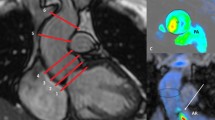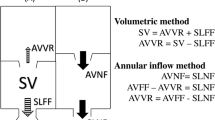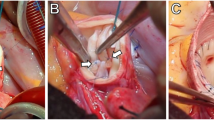Abstract
Holodiastolic flow reversal in the descending aorta on echocardiogram suggests significant aortic regurgitation. The study aim was to determine whether the presence of holodiastolic flow reversal on cardiac magnetic resonance imaging (MRI) correlates with aortic valve regurgitant fraction. We retrospectively reviewed 166 cardiac MRIs (64 % male, age 14.1 ± 9.5 years) from January 2011 to May 2012 where velocity mapping was acquired at both the aortic valve and the descending aorta at the level of the diaphragm. Descending aorta velocity maps were checked for baseline offset using a static reference region. Holodiastolic flow reversal was defined as flow reversal throughout diastole both before and after baseline correction. Significant aortic regurgitation was defined as regurgitant fraction >10 %. Aortic valve regurgitant fraction was <10 % in 144 patients (Group A), 10–20 % inclusive in 7 patients (Group B), and >20 % in 15 patients (Group C). Though the aortic valve regurgitant fraction was significantly higher for patients with holodiastolic flow reversal versus those without (8.5 ± 14.2 vs. 3.8 ± 6.6 %, p = 0.02), holodiastolic flow reversal was present in 32 Group A patients (22 %). In comparison, 4 Group B patients (57 %) and 7 Group C patients (47 %) had holodiastolic flow reversal. The sensitivity (Groups B and C) was 0.5, and the specificity (Group A) was 0.78. Holodiastolic flow reversal in the descending aorta on cardiac MRI was neither sensitive nor specific for predicting significant aortic regurgitation in this study population. Holodiastolic flow reversal in the absence of significant aortic regurgitation may be a relatively common finding in patients with congenital heart disease.



Similar content being viewed by others
References
Bonow RO, Carabello B, deLeon Jr AC et al (1998) Guidelines for the management of patients with valvular heart disease: executive summary. A report of the American College of Cardiology/American Heart Association Task Force on Practice Guidelines (Committee on Management of Patients with Valvular Heart Disease). Circulation 98:1949–1984
Zoghbi WA, Enriquez-Sarano M, Foster E et al (2003) American Society of Echocardiography: recommendations for evaluation of the severity of native valvular regurgitation with two-dimensional and Doppler echocardiography. Eur J Echocardiogr 4:237–261
Takenaka K, Dabestani A, Gardin JM et al (1986) A simple Doppler echocardiographic method for estimating severity of aortic regurgitation. Am J Cardiol 57:1340–1343
Touche T, Prasquier R, Nitenberg A, de Zuttere D, Gourgon R (1985) Assessment and follow-up of patients with aortic regurgitation by an updated Doppler echocardiographic measurement of the regurgitant fraction in the aortic arch. Circulation 72:819–824
Tribouilloy C, Avinee P, Shen WF, Rey JL, Slama M, Lesbre JP (1991) End diastolic flow velocity just beneath the aortic isthmus assessed by pulsed Doppler echocardiography: a new predictor of the aortic regurgitant fraction. Br Heart J 65:37–40
Bolen MA, Popovic ZB, Rajiah P et al (2011) Flow reversal in the descending aorta helps stratify severity. Radiology 260:98–104
Tani LY, Minich L, Daw RW, Orsmond GS, Shaddy RS (1997) Doppler evaluation of aortic regurgitation in children. Am J Cardiol 80:927–931
Cox DA, Walton K, Bartz PJ, Tweddell JS, Frommelt PC, Earing MG (2013) Predicting left ventricular recovery after replacement of a regurgitant aortic valve in pediatric and young adult patients: is it ever too late? Pediatr Cardiol 34:694–699
Higgins CB, Wagner S, Kondo C, Suzuki J, Caputo GR (1991) Evaluation of valvular heart disease with cine gradient echo magnetic resonance imaging. Circulation 84:1198–1207
Globits S, Frank H, Mayr H, Neuhold A, Glogar D (1992) Quantitative assessment of aortic regurgitation by magnetic resonance imaging. Eur Heart J 13:78–83
Sechtem U, Pflugfelder PW, Cassidy MM et al (1998) Mitral or aortic regurgitation: quantification of regurgitant volumes with cine MR imaging. Radiology 167:425–430
Gelfand EV, Hughes S, Hauser TH et al (2006) Severity of mitral and aortic regurgitation as assessed by cardiovascular magnetic resonance: optimizing correlation with Doppler echocardiography. J Cardiovasc Magn Reson 8:503–507
Whitehead KK, Sundareswaran KS, Parks WJ, Harris MA, Yoganathan AP, Fogel MA (2009) Blood flow distribution in a large series of patients having the Fontan operation: a cardiac magnetic resonance velocity mapping study. J Thorac Cardiovasc Surg 138:96–102
Harris MA, Weinberg PM, Whitehead KK, Fogel MA (2005) Usefulness of branch pulmonary artery regurgitant fraction to estimate the relative right and left pulmonary vascular resistances in congenital heart disease. Am J Cardiol 95:1514–1517
Harris MA, Whitehead KK, Gillespie MJ et al (2011) Differential branch pulmonary artery regurgitant fraction is a function of differential pulmonary arterial anatomy and pulmonary vascular resistance. JACC Cardiovasc Imaging 4:506–513
Hauser M, Kuhn A, Petzuch K, Wolf P, Vogt M (2013) Elastic properties of the ascending aorta in healthy children and adolescents. Age-related reference values for aortic wall stiffness and distensibility obtained on M-mode echocardiography. Circ J 77:3007–3014
Niwa K (2013) Aortopathy in congenital heart disease in adults: aortic dilatation with decreased aortic elasticity that impact negatively on left ventricular function. Korean Circ J 43:215–220
Seki M, Kurishima C, Saiki H et al (2014) Progressive aortic dilation and aortic stiffness in children with repaired tetralogy of Fallot. Heart Vessels 29:83–87
Rutz T, Max F, Wahl A et al (2012) Distensibility and diameter of ascending aorta assessed by cardiac magnetic resonance imaging in adults with tetralogy of Fallot or complete transposition. Am J Cardiol 110:103–108
Seki M, Kurishima C, Kawaski H, Masutani S, Senzaki H (2012) Aortic stiffness and aortic dilation in infants and children with tetralogy of Fallot before corrective surgery: evidence for intrinsically abnormal aortic mechanical property. Eur J Cardiothorac Surg 41:277–282
Chowdhury UK, Mishra AK, Ray R, Kalaivani M, Reddy SM, Venugopal P (2008) Histopathologic changes in ascending aorta and risk factors related to histopathologic conditions and aortic dilatation in patients with tetralogy of Fallot. J Thorac Cardiovasc Surg 135:69–77
Tan JL, Davlouros PA, McCarthy KP, Gatzoulis MA, Ho SY (2005) Intrinsic histologic abnormalities of aortic root and ascending aorta in tetralogy of Fallot: evidence of causative mechanism for aortic dilatation and aortopathy. Circulation 112:961–968
Niwa K (2005) Aortic root dilatation in tetralogy of Fallot long-term after repair–histology of the aorta in tetralogy of Fallot: evidence of intrinsic aortopathy. Int J Cardiol 103:117–119
Funding
This research received no specific grant from any funding agency, commercial or not-for-profit sectors.
Author information
Authors and Affiliations
Corresponding author
Ethics declarations
Conflict of interest
None.
Additional information
Catherine M. Avitabile and Kevin K. Whitehead have contributed equally to this work.
Rights and permissions
About this article
Cite this article
Avitabile, C.M., Whitehead, K.K., Fogel, M.A. et al. Holodiastolic Flow Reversal at the Descending Aorta on Cardiac Magnetic Resonance is Neither Sensitive Nor Specific for Significant Aortic Regurgitation in Patients with Congenital Heart Disease. Pediatr Cardiol 37, 1284–1289 (2016). https://doi.org/10.1007/s00246-016-1430-7
Received:
Accepted:
Published:
Issue Date:
DOI: https://doi.org/10.1007/s00246-016-1430-7




